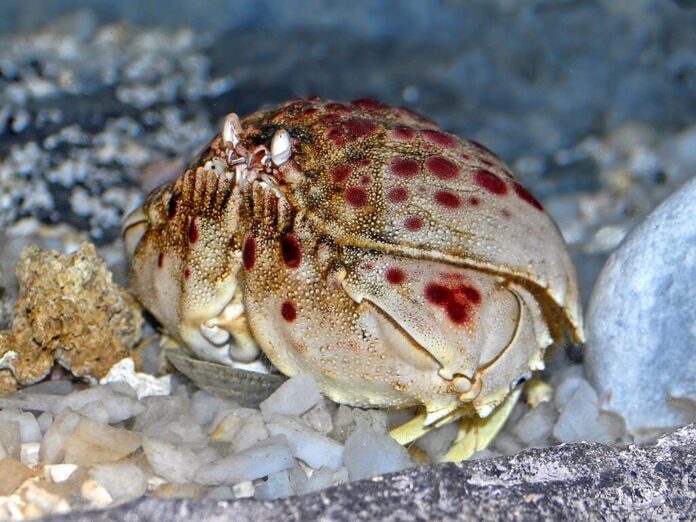Smooth box crab has a very unique appearance, and those claws are one of the reasons why. Appearance aside, this decapod is actually popular because of the taste of the meat from its legs. However, there are certain levels of toxicity that the crabs contain, which make them somehow dangerous to consume. Today, we will talk about them in general so that we know them beyond cuisine.
1Appearance

A smooth box crab has a smooth carapace at a size of around 15 centimeters, and it has large pincers. The carapace curves downwards, and this is to protect their legs. Its coloration is variable, but a smooth box crab is usually light yellow, and some have red dots. Along with that, it has large front claws that allow it to protect its vulnerable appendages and its front body. In fact, these crabs got their name from the large claws that somehow make them look like a box.
If you look closely, you can see that the claws are the same in size but different in shape. The right claw has a large hook that it uses for crushing mollusks. As for the left claw, it is more delicate, and the crab uses it to pick the pieces out of the crushed shell. Useful but somehow a nuisance, these two features can get in the way when they try to mate. This is why most crabs only mate while they are molting.
2Behavior
Some find it romantic, while others find it creepy when it comes to male smooth box crabs. Females that are about to molt release pheromones that attract the males. The thing is that some males will rush into a group of females and grab all of them. Not to mention some females are already being held by another male. Once a male smooth box crab finds a female, he will keep her in his embrace for days, until she molts. After mating, he guards her for a day or two until her new shell has hardened. Then, he releases her and goes in pursuit of a new mate.
Hiding in the sand is a smooth box crab’s defense mechanism, keeping themselves and their mates safe. They use the rear of their carapace to push themselves downwards and backwards into the sand, very quickly. Since their eyes and respiratory organs are on the top of their head, they can see and breathe while hiding with their mate.
3Feeding & Habitats

Smooth box crab has a distribution across the Indo-Pacific, living in the intertidal zone. Its range is from the East Coast of Africa across to Hawaii, all the way to Japan and Australia. These crabs are active during the night, and they mostly feed on crustaceans, worms, and mollusks such as clams. Their claws are so powerful that they can even prey on hermit crabs with super strong shells. They feed by steadying the prey with their legs and then using the pincers to open it up. And for them as food, people do eat them, but there have been reports of marginal toxicity. Being tasty and all, it is also important to be cautious when eating one.
Related Post: Shame-Faced Crab Facts




